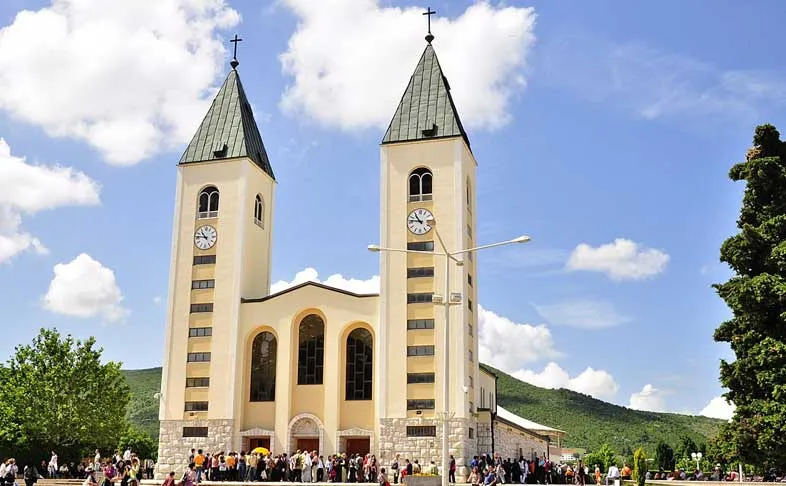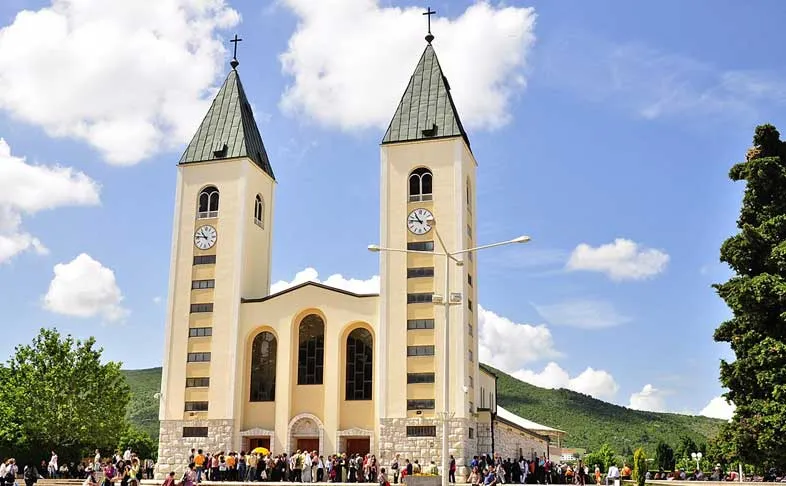
Introduction
Sanctuary of Our Lady of Medjugorje all known as Sanctuary of Our Lady Queen of Peace in Medjugorje, which is a town located in south-western Bosnia and Herzegovina, about 25 km (16 mi) southwest of Mostar and 20 km (12 mi) east of the border with Croatia. The town is part of the Čitluk municipality and geographically part of Herzegovina. Since 1981, it has become a popular site of Catholic pilgrimage due to Our Lady of Međugorje, a purported series of apparitions of Mary, mother of Jesus, to six local children that are supposedly still happening to this day.
The name Međugorje literally means “between mountains”. At an altitude of 200 m (660 ft) above sea level it has a mild Mediterranean climate. The town consists of an ethnically homogeneous Croat population of 2,306. The Roman Catholic parish includes four neighbouring villages: Bijakovići, Vionica, Miletina and Šurmanci. Since 2019, pilgrimages to Medjugorje have been authorized by the Vatican.
To the east of Međugorje in the Neretva valley, the Serbian Orthodox Žitomislić Monastery has stood since 1566. Gravestones erected in the Middle Ages have remained to this day in the Catholic cemetery Groblje Srebrenica in the hamlet of Miletina as well as in the hamlet of Vionica. In the area of the cemetery in Miletina, structures from the Roman era stood, whose ruins have not yet been fully excavated.
Part of the Ottoman Empire until 1878, it became part of Austria-Hungary (War of 1878, Annexion 1908). In 1882 the railway line between Mostar and the Adriatic coast of Dalmatia was built, with a station in the hamlet of Šurmanci, through which the village gained access to the railway network.
The Catholic parish of Sveti Jakov (“Saint James”) was erected in 1892 by the Bishop of Mostar Paškal Buconjić. The twelve-metre tall crucifix on the mountain called Križevac (Cross Mountain), completing the parish’s Stations of the Cross (križni put), was completed in 1934.
History of Shrine of Our Lady of Medjugorje
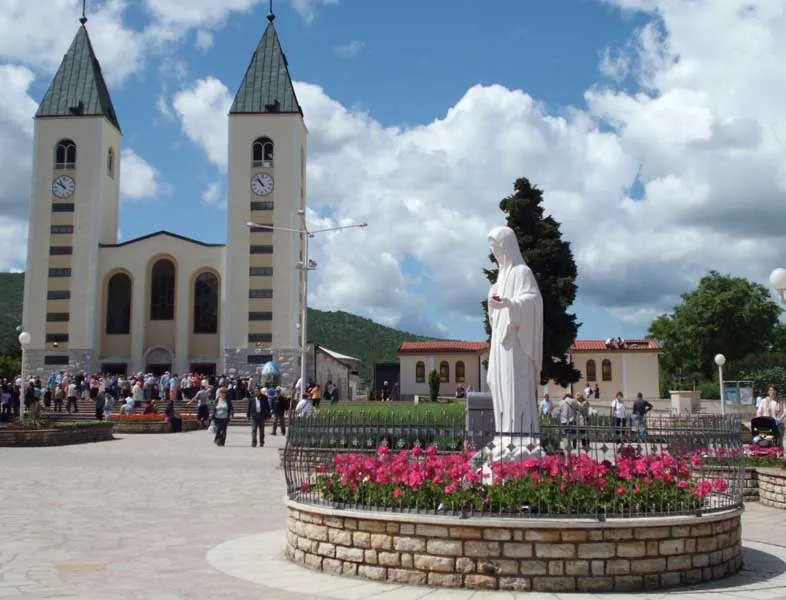
At the time of the apparitions, the village of Medjugorje was in Bosnia and Herzegovina. part of the Socialist Federal Republic of Yugoslavia, a federation of various Slavic nations. There were tensions among the nations, exacerbated by religious difference: most Croats are Catholic, most Serbs are Eastern Orthodox, while the Bosnians and Herzegovinians are a mix of the two and included in the third group – the Bosnian Muslims.
The death of President Josip Broz Tito in early May 1980 had led to anti-communist backlash and the build up of ethnic tensions, destabilizing the country. Yugoslavia was moving towards political, economic, and national collapse.
The political crisis generated the economic one and the public debt soared. The Albanian anti-Serb riots in Kosovo in 1981 were an example of national dissatisfaction. After Tito’s death, the security apparatus enhanced its activities against the perceived “enemies of the state”, especially in Bosnia and Herzegovina, where the apparatus was most loyal to Tito. Such activity was especially oriented towards the Catholic Church in Herzegovina.
In addition, the election of the Pope John Paul II from the communist Poland and the Catholic Solidarity Movement intensified the conflict between the Vatican and the Soviet-dominated Eastern Europe. In the 1980s there was a boom of Marian apparitions in Europe, especially in Ireland and Italy. Chris Maunder connects these apparitions, including those in Medjugorje, with the anti-communist movement in Eastern Europe that led to the downfall of communism.
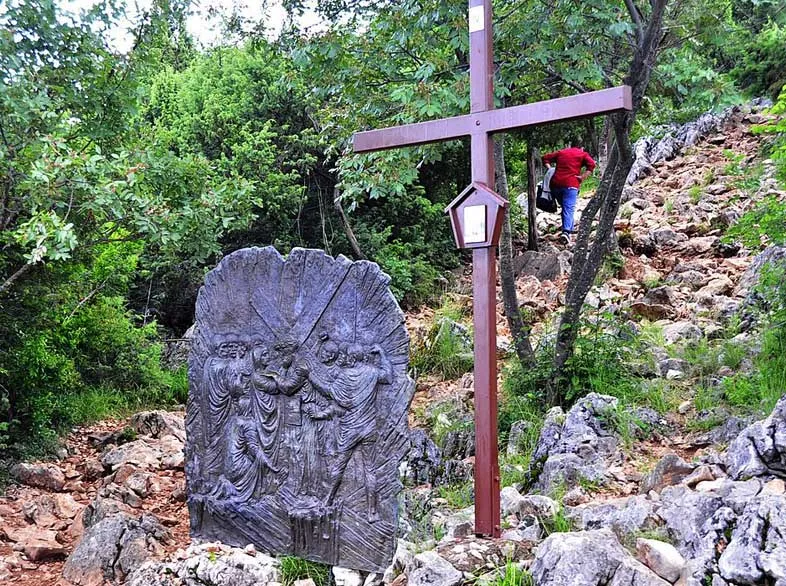
Shrine of Our Lady of Medjugorje – The Franciscan Province of Herzegovina was established in 1843 when it seceded from the Franciscan Province of Bosna Srebrena. In 1846, the Holy See established the Apostolic Vicariate of Herzegovina, which was then part of the Ottoman Empire and it was considered to be a mission area.
The first vicars were all Franciscans. In 1881, the area came under the control of the Austro-Hungarian Empire and Pope Leo XIII took steps to establish dioceses and appoint local bishops. As part of re-establishing normal church structures, the bishops worked to transfer parishes from the Franciscans to the diocesan clergy. The Apostolic Vicariate was elevated to the Diocese of Mostar-Duvno, which included Medjugorje.
The Franciscans of Herzegovina saw this as a threat, depriving them of a source of income and their role as community social leaders which they attained over centuries of “difficult missionary” work while under Turkish domination.
A jurisdictional conflict arose, known as the Herzegovina Affair or Herzegovina Case which dates back to 1923, when Rome made a decision to have the Franciscans turn over half of the parishes they control to the secular clergy. A smooth transition was inhibited by both a lack of sufficient diocesan clergy and by the resistance of the friars to the divestment of their parishes.
The Franciscans complied only partially and have refused to comply with Rome’s decisions ever since. Their resistance to this change put them into conflict with the Church’s hierarchy, including their Franciscan Order in Rome. Their resistance to comply was against both church authority and canon law.
Architecture of Shrine of Our Lady of Medjugorje
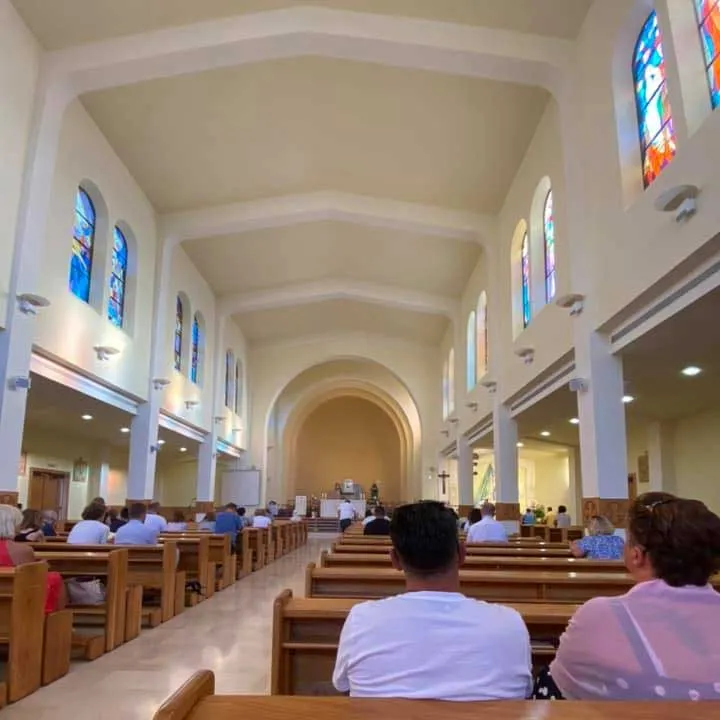
In 1933 Pope Pius XI requested the whole Catholic world to erect crosses on the dominant mountains in honor of the 1900th anniversary of the crucifixion of Jesus. In 1933 a massive cross was erected by the local Catholic diocese on a mountain near Medjuorje. The 1,770-foot peak was originally named Mount Sipovac but the locals changed the name to Mount Krizevac which means “Mount of the Cross.” They constructed the 33-foot-high cross weighing fifteen tons in six weeks, carrying all the building materials on their backs.
In 1975, Pope Paul VI, Romanis Pontificibus, decreed that the Franciscans must withdraw from most of the parishes in the Diocese of Mostar-Duvno, retaining 30 and leaving 52 to the diocesan clergy. In the 1980s the Franciscans still held 40 parishes under the direction of 80 friars. In August 1980, the new bishop of Mostar, Pavao Zanic immediately announced that only one quarter of the city would remain under the Franciscans. The Mostar Cathedral of Mary, Mother of the Church was completed in the summer of 1980.
According to Michael Budde in his book Beyond the Borders of Baptism Catholicity, Allegiances, and Lived Identities, as it gained a national and international reputation, the Medjugorje pilgrimage site became a formidable symbol of the power of religion in the fight against the Communist Yugoslav regime.
Our Lady of Medjugorje (Reported Apparitions)
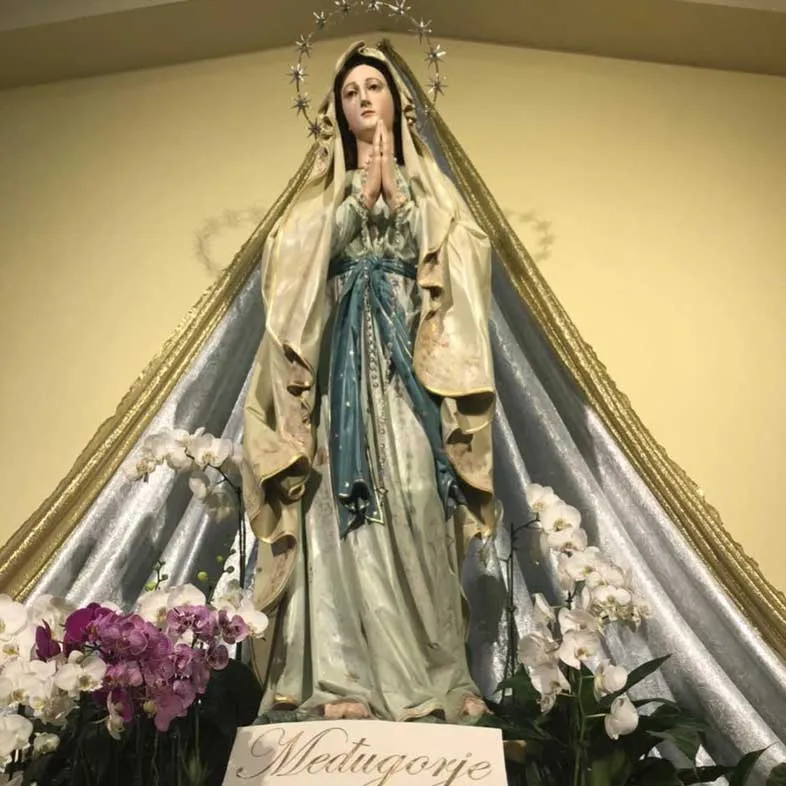
Our Lady of Medjugorje (Croatian: Međugorska Gospa), also called Queen of Peace (Croatian: Kraljica mira) and Mother of the Redeemer (Croatian: Majka Otkupiteljica), is the title given to visions of Mary, the mother of Jesus, which began in 1981 to six Herzegovinian Croat teenagers in Medjugorje, Bosnia and Herzegovina (at the time in SFR Yugoslavia). The alleged visionaries are Ivan Dragičević, Ivanka Ivanković, Jakov Čolo, Marija Pavlović, Mirjana Dragičević and Vicka Ivanković. They ranged from ten to sixteen years old at the time of the first apparition.
On 24 June 1981 around 6:30pm, fifteen-year-old Ivanka Ivanković and her friend, a sixteen-year-old, Mirjana Dragičević, were on a walk to talk and have a smoke. Ivanka was startled to notice the shimmering silhouette of a woman bathed in a brilliant light on nearby Mount Podbrdo. She immediately said, “Mirjana, look, it’s Gospa!” (Our Lady) She brought this to Marijana’s attention, but Marija scoffed at the idea and they continued on their way. They then met Milka Pavlovic, 13, who asked them to help bring in the sheep, so the three returned to the nearby hill, where all three saw the apparition.
They were then joined by their friend Vicka Ivanković, 17, who saw the Gospa and was so frightened, she ran down the hill. Driven by curiosity, she returned with Ivan Dragičević, 16, and Ivan Ivankovic, 20 who were picking apples. Ivan Dragičević was so frightened that he dropped his apples and bolted. Later they said they all saw the same apparition. “The Medjugorje visions began only days after Orthodox Serbs commemorated the 40th anniversary of mass killings of Serbs by the Ustaše at Šurmanci during the Second World War.”
The next day Ivanka Ivankovic, Mirjana Dragicevic, Vicka Ivankovic, and Ivan Dragicevic returned to the site. Ivan Ivankovic did not accompany them. As Milka Pavlovic’s mother kept her home to help in the garden, Vicka Ivankovic brought along Milka’s sister, Marija Pavlovic, and ten-year-old Jakov Colo. Milka experienced no further apparitions. The six seers told the Franciscan friar Father Jozo Zovko, who was the parish priest at St. James Church in Medjugorje, that they had seen the Virgin Mary (Gospa).
He was initially skeptical. He noticed that the seers became agitated if anyone hinted that were lying and he was taken by the fact that their physical descriptions of the Gospa were consistent with each other. According to Randall Sullivan, they described her as “…a young woman about twenty years old, they said, with blue eyes, black hair, and a crown of stars around Her head; She wore a white veil and bluish-grey robe.
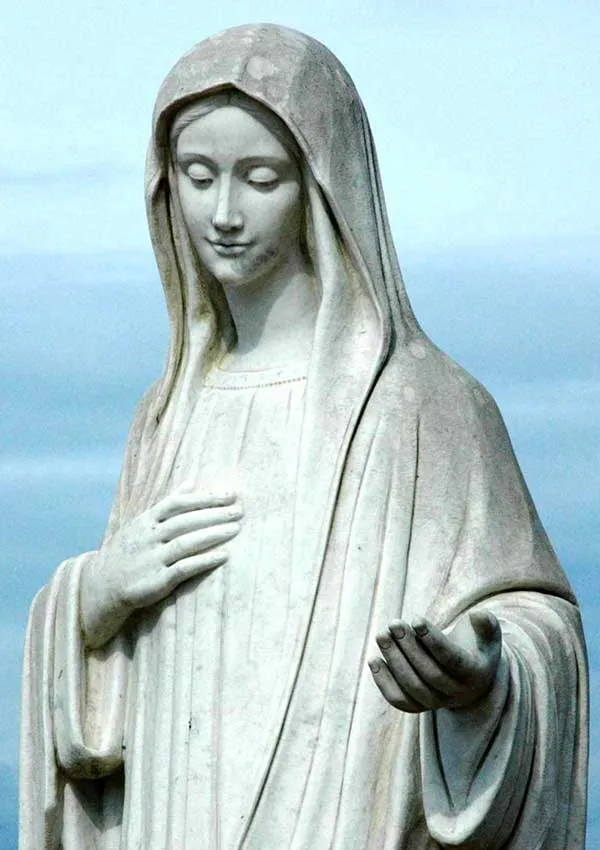
Each of the children said they had not been able to see the Virgin’s feet, described Her as hovering just above the ground on a white cloud, and said she spoke in a singing voice.” In early July, pastor Jozo Zovko rejected his initial skepticism and embraced the apparitions.
The Mostar Cathedral of Mary, Mother of the Church was completed in the summer of 1980. In order to create the cathedral parish it was decided to split the parish of SS. Peter and Paul. The Franciscans objected to this as being unfair. Friars Ivica Vego and Ivan Prusina, were chaplains in the parish of SS Peter and Paul in Mostar, who refused to obey the Papal decree Romanis Pontificibus and relocate from the parish.
After several warnings, Bishop Žanić suspended their priestly faculties throughout the dioceses under his jurisdiction. Yugoslav officials condemned the reports as “clerical-nationalist” conspiracy on the part of Croat extremists. Bishop Žanić took a stand for the seers and the local Franciscans against the communist authorities who tried to prosecute them. He informed the Pope about the events in September 1981.
Vicka allegedly received messages from the Madonna from 19 December 1981 until 29 September 1982, and recorded them in her diary. On 21 September Fr. Ivan Prusina, along with other Franciscans, with the help of the crowd, violently expelled diocesan priests from the parish.
On 15 January 1982, the bishop invited the alleged seers to his residence to ask them if there were any messages from the Madonna on the issue, and they replied that there were not. However, on 3 April 1982, the seers came to the bishop to tell him that the Madonna scolded them for not telling the truth and that she requested that the two friars remain in Mostar and continue to celebrate mass and hear confessions. The Madonna allegedly told Vicka that Fr. Ivan Prusina and Fr. Ivica Vego “are not guilty of anything” in the matter. Tomislav Vlašić took responsibility for the lies of the seers telling the bishop he instructed them not to tell the truth because the bishop might dispute the authenticity of the apparitions.
On 21 June 1983, one of the seers, Ivan Dragičević, sent a threatening message allegedly from the Madonna to the bishop, in which she requests the bishop’s conversion regarding her apparitions, otherwise, he would be “judged by me and my son Jesus.” On 6 February 1985, Ivan Dragičević sent somewhat more tolerant message from the Madonna, with her stating that if he doesn’t believe in her apparitions, at least he shouldn’t persecute her priests who believe in her messages and promote them.”
In the opinion of Peter Jan Margry’s, the deviancy of such reported Marian apparitions is observed in their formal espousing of Catholic teachings, and obedience to the Church and the Pope, while in practice, they consider the messages to be authentic revelations, have connections to excommunicated priests, and disobey the Church and the Pope.
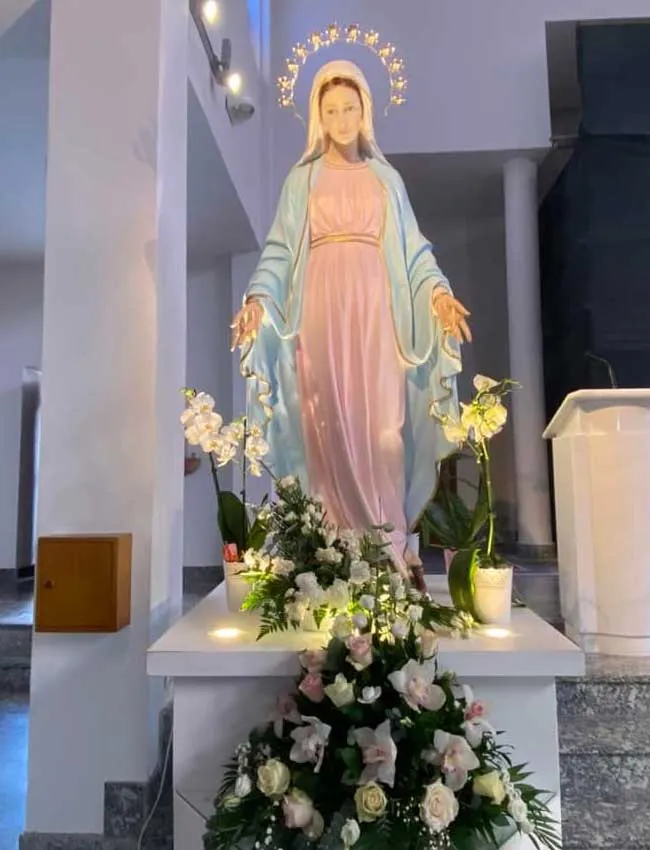
The Archbishop of Split-Makarska Frane Franić, who supported the alleged apparitions from the beginning, tried to persuade Vicka to retract the messages about the two friars, so the authenticity of the apparitions could be defended more easily. However, both Vicka and Ivan continued to claim that the messages regarding the two friars were from the Madonna. The messages included the accusations against Bishop Pavao Žanić and encouragement for the two friars not to leave the parish. It was then when Bishop Pavao took his final negative stance on the alleged apparitions.
The whole of that time, the Bishop remained cautious towards the apparitions, without any final conclusion. He became skeptical towards the apparitions after the apparition accused him of the disorder in Herzegovina that existed between the Franciscans and the diocesan clergy and defended the two Franciscans who refused to leave their parishes as requested by the Papal decree Romanis Pontificibus.
Because of his disobedience, Fr. Ivan Prusina had his priestly jurisdiction revoked by Bishop Pavao Žanić on 9 October 1980. Fr. Ivan Prusina and Fr. Ivica Vego appealed to the Franciscan Order and the Congregation for Clergy, who declined their appeal considering the decisions to be final. However, the Apostolic Signatura, the highest judicial court of the Holy See, concluded on 27 March 1993 that they had a right on appeal and saw this as a violation of the procedure and declared the dismissal to be null and void; the same followed for Fr. Ivica Vego as well.
The Franciscan Province of Herzegovina tried to present this as a sign of victory against the bishop, however, the bishop’s revocation of Fr. Ivan Prusina’s priestly jurisdiction remained in force, and the Apostolic Signature never reviewed the matter itself, only the procedural defects. It later became known that Fr. Ivica Vego had impregnated a nun, whom he eventually married and lives with her near Medjugorje. Velikonja wrote that it “would not have succeeded had it not been for the rich and long religious tradition of the region.”
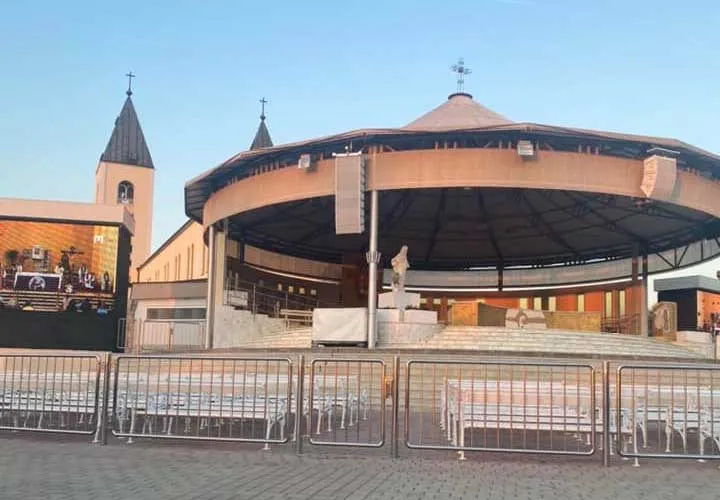
Međugorje during the Bosnian War
Shrine of Our Lady of Medjugorje – During the Bosnian War, Medjugorje remained in the hands of the Croatian Defence Council and in 1993 became part of the Croatian Republic of Herzeg-Bosnia. By the Dayton Agreement in 1995, Medjugorje was incorporated into the Federation of Bosnia and Herzegovina, populated mostly by Bosniaks and Croats. It lies within the Herzegovina-Neretva Canton, one of ten autonomous regions established so that no ethnic group could dominate the Federation.
On 2 April 1995, at the high point of conflict within the local diocese, Bishop Ratko Perić was kidnapped by Croat militiamen, beaten, and taken to a chapel run by one of the Franciscans associated with Međugorje, where he was held hostage for ten hours. At the initiative of the mayor of Mostar, he was freed without bloodshed, with the help of the United Nations Protection Force.
The Dutch professor of anthropology at the Free University, Amsterdam, Mart Bax, wrote in several publications that there had been mass killings due to a vendetta between clans during the beginning of the Bosnian War in 1991 and 1992. After much investigative research by journalists in several newspapers and comments from other scholars it appears unlikely that these mass killings ever occurred.
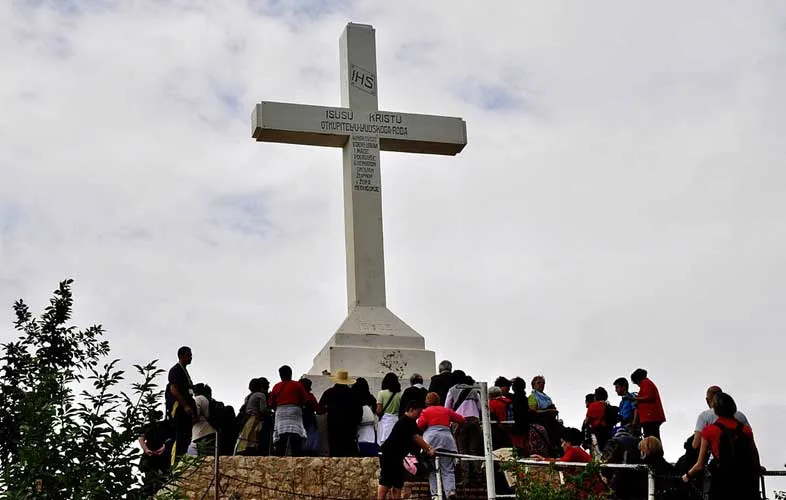
Development After The War
Shrine of Our Lady of Medjugorje – After the Bosnian War ended, peace came to the area and UN peace troops were stationed in western Herzegovina. Efforts by a politician, Ante Jelavić, to create a Croatian entity were unsuccessful, and Međugorje remained part of the Federation of Bosnia and Herzegovina. The town and its environs boomed economically after the war. Over a thousand hotel and hostel beds are available for pilgrims to the town. With approximately one million visitors annually, the municipality of Medjugorje has the most overnight stays in Bosnia-Herzegovina.
The Mostar International Airport, located approximately 20 km (12 mi) to the northeast and which was closed in 1991, reopened for civil aviation in 1998 and has made air travel to region easier since then. The road network was expanded after the Bosnian War. In addition the hamlet of Šurmanci in the lower Neretva valley has a train station on the route from Ploče to Sarajevo.
On 6 April 2001, demonstrations occurred in the region, with some violence, after the NATO-led Stabilisation Force had closed and searched the local branches of the Hercegovačka banka (“Herzegovina Bank”), through which a large part of the currency transactions in Herzegovina, including international donations intended for Međugorje, were carried out, on suspicion of white-collar crime. The Franciscan Province responsible for the parish was a shareholder of the bank.
On 11 February 2017, Pope Francis named Archbishop Hoser from Poland his special envoy to Međugorje, tasked with assessing its pastoral needs. A couple of months later Hoser finished his work and returned home.
On 31 May 2018, Pope Francis named Hoser as special apostolic visitor to Međugorje, for “an undefined period and at nutum Sanctae Sedis” (at the disposal of the Holy See). The aim of this mission is “ensuring a stable and continuous accompaniment to the parish community of Medjugorje and to the faithful who go there as pilgrims, and whose needs require particular attention.”
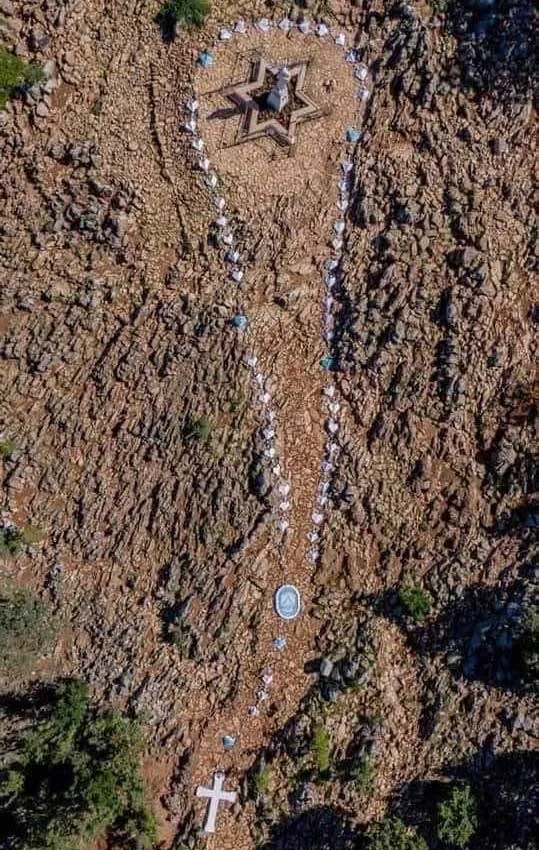
Pilgrimage to Medjugorje authorized by Vatican
On 12 May 2019, the Vatican officially authorized pilgrimage to Medjugorje. The first Vatican sanctioned pilgrimage then took place for five days from 2-6 August 2019. During the pilgrimage, approximately 60,000 young Catholics from 97 countries took part in the celebration of a youth festival. Fourteen archbishops and bishops and about 700 Catholic priests joined the festivities as well.
Feast Day
Annual Feast Day of Our Lady of Medjugorje (Queen of Peace) held on 25th June.
Mass Time
Weekdays
- 7:30 am
- 7:00 pm
Sundays
- 8:00 am
- 11:00 am
- 7:00 pm
Church Visiting Time
Every Days : Open 24 Hours.
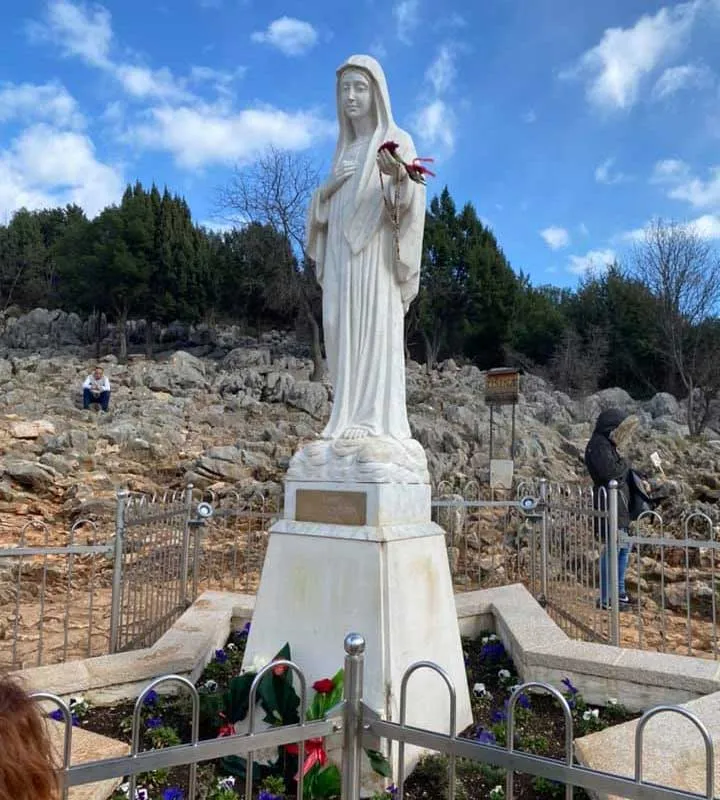
Contact Info
Shrine of Our Lady of Medjugorje,
5MRH+52V, Međugorje 88260,
Bosnia & Herzegovina.
Phone No.
Tel : +387 36 651-988
Accommodations
How to reach the Shrine
Mostar International Airport in Gnojnice, Bosnia and Herzegovina is the nearby Airport to the Shrine.
Žitomislići Train Station in Bosnia and Herzegovina is the nearby Train Station to the Shrine.

